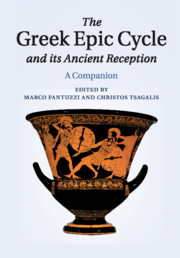Book contents
- Frontmatter
- Contents
- List of illustrations
- List of contributors
- Editorial note
- Introduction: Kyklos, the Epic Cycle and Cyclic poetry
- PART I APPROACHES TO THE EPIC CYCLE
- PART II EPICS
- PART III THE FORTUNE OF THE EPIC CYCLE IN THE ANCIENT WORLD
- 22 The aesthetics of sequentiality and its discontents
- 23 The Epic Cycle, Stesichorus, and Ibycus
- 24 Pindar's Cycle
- 25 Tragedy and the Epic Cycle
- 26 The Hellenistic reception of the Epic Cycle
- 27 Running rings round Troy: Recycling the ‘Epic Circle’ in Hellenistic and Roman art
- 28 Virgil and the Epic Cycle
- 29 Ovid and the Epic Cycle
- 30 Statius' Achilleid and the Cypria
- 31 The Epic Cycle and the ancient novel
- 32 The Epic Cycle and imperial Greek epic
- Works cited
- Index of principal passages
- Index nominum et rerum
27 - Running rings round Troy: Recycling the ‘Epic Circle’ in Hellenistic and Roman art
from PART III - THE FORTUNE OF THE EPIC CYCLE IN THE ANCIENT WORLD
Published online by Cambridge University Press: 05 August 2015
- Frontmatter
- Contents
- List of illustrations
- List of contributors
- Editorial note
- Introduction: Kyklos, the Epic Cycle and Cyclic poetry
- PART I APPROACHES TO THE EPIC CYCLE
- PART II EPICS
- PART III THE FORTUNE OF THE EPIC CYCLE IN THE ANCIENT WORLD
- 22 The aesthetics of sequentiality and its discontents
- 23 The Epic Cycle, Stesichorus, and Ibycus
- 24 Pindar's Cycle
- 25 Tragedy and the Epic Cycle
- 26 The Hellenistic reception of the Epic Cycle
- 27 Running rings round Troy: Recycling the ‘Epic Circle’ in Hellenistic and Roman art
- 28 Virgil and the Epic Cycle
- 29 Ovid and the Epic Cycle
- 30 Statius' Achilleid and the Cypria
- 31 The Epic Cycle and the ancient novel
- 32 The Epic Cycle and imperial Greek epic
- Works cited
- Index of principal passages
- Index nominum et rerum
Summary
Literary responses to (what we call) the ‘Epic Cycle’ are not always literally ‘literary’. In addition to the numerous Greek and Roman poets who engaged with the poems and their stories, artists offered distinctive visual interpretations of their own. Right from the beginnings of Late Geometric Greek figurative art, we find sculptors and painters responding to the tales of Troy, actively adding new twists and variations – necessarily changing the stories as much as passively ‘following’ them.
This visual interest in Epic Cyclic stories intensified in the Hellenistic world. Although – as with the Epic Cycle poems themselves – we have only a tiny fraction of the original paintings, mosaics and sculptures produced, we know that the Epic Cycle played a major role. Textual sources confirm that such subjects appealed right to the top of the political and social orders: when decorating his famous ship in the third century BC, for example, Hieron II is said to have commissioned a series of mosaics ‘on which the entire story of the Iliad was wonderfully wrought’ (ἐν οἷς κατεσκευασμένος πᾶς ὁ περὶ τὴν Ἰλιάδα μῦθος θαυμασίως: Athen. 5.207 c). Related cycles of paintings were also collected in Rome: Pliny the Elder records how a series on ‘the Trojan War in many panels’ (bellumque Iliacum pluribus tabulis, HN 35.144) came to be displayed in the Portico of Philip, attributed to a certain Theorus.
Works like these might be lost. But extant Hellenistic and Roman visual materials nonetheless testify to the popularity of Epic Cycle themes, and across a broad range of different media. My aim in this chapter is to offer a brief preliminary survey of those surviving objects and paintings. At the same time, I also want to rethink exactly what these ‘testimonia’ attest. Rather than use the material record to reconstruct the content or narrative mode of the poems, the chapter aims at something both less and more ambitious: to show how pictorial engagements with the Epic Cycle could parallel and develop the literary concerns of contemporary poetic texts.
- Type
- Chapter
- Information
- The Greek Epic Cycle and its Ancient ReceptionA Companion, pp. 496 - 542Publisher: Cambridge University PressPrint publication year: 2015
- 3
- Cited by



